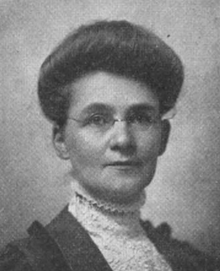Martha Meir Allen
Martha Meir Allen (March 31, 1854 – 1926) was a Canadian temperance activist and writer.
Martha Meir Allen | |
|---|---|
 | |
| Born | March 31, 1854 Owen Sound, Canada |
| Died | 1926 (aged 71–72) |
| Occupation | Temperance activist, writer |
Biography
Allen was born at Owen Sound.[1] She married Rev. James E. Allen in June, 1880 and they moved to New York in 1885. She became active in the temperance movement.[1] In 1889, Allen was appointed Superintendent of the Department of Non-Alcoholic Medication for the National Woman's Christian Temperance Union.[2] In 1906, she became Superintendent of the Department of Medical Temperance.[2]
Allen campaigned against the medical use of alcoholic liquors and against soft drinks containing drugs.[3] To determine alcohol content Allen took samples of proprietary remedies to the Massachusetts State Board of Health for analysis.[4] The chemists found that the preparations contained from 5 to 40 percent alcohol. She presented the results in 1887 at a convention in Buffalo, New York.[4] Allen published the results in an article, "The Danger and Harmfulness of Patent Medicines" in the Christian Advocate which revealed the presence of alcohol in patent medicines.[2][4] She campaigned against the use of whisky in the treatment of tuberculosis.[2] Allen attempted to persuade the Massachusetts Medical Association to denounce the use of alcohol and narcotics.[4]
As Superintendent of the Department of Medical Temperance she was involved in a national program that exposed dangerous patent medicines and liquid foods.[4] The department aimed to convince medical authorities to discontinue prescribing alcohol. The national department sent 25,000 leaflets to local and state unions outlining their objectives.[4] Allen reported that non-alcoholic medicine was "growing in favor" and new members were specializing in activism. The department was responsible for generating a large amount of pure drink and temperance literature.[4]
Allen represented the United States at the Twelfth International Congress on Alcoholism held in London in 1909.[1][2] She authored Alcohol a Dangerous and Unnecessary Medicine, in 1900.[1] A new issue was published in 1910 and copies were placed in medical libraries across Canada and the United States.[2] A review in the Journal of the American Medical Association commented that it is "worthy of respectful consideration by physicians, though all may not accept fully its conclusions".[5] It has been described as the first book that provided evidence against fraudulent patent medicine testimonials.[4]
Selected publications
References
- Hoolihan, Christopher. (2008). An Annotated Catalogue of the Edward C. Atwater Collection of American Popular Medicine and Health Reform, Volume 3. University of Rochester Press. p. 10. ISBN 978-1-58046-284-6
- Cherrington, Ernest Hurst. (1925). Standard Encyclopedia of the Alcohol Problem, Volume 1. American Issue Publishing Company. pp. 145-146
- Who's Who Among North American Authors, Volume 1. Golden Syndicate Publishing Company, 1921. p. 5
- Goodwin, Lorine Swainston. (1999). The Pure Food, Drink, and Drug Crusaders, 1879-1914. McFarland. pp. 123-125. ISBN 978-0-7864-2742-0
- "Alcohol a Dangerous and Unnecessary Medicine". JAMA. 55 (6): 523. 1910.